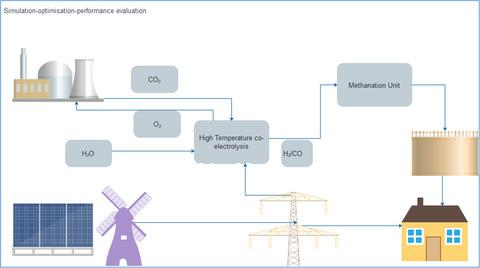当前位置:
X-MOL 学术
›
Energy Sci. Eng.
›
论文详情
Our official English website, www.x-mol.net, welcomes your
feedback! (Note: you will need to create a separate account there.)
Performance evaluation, Optimization and exergy analysis of a high temperature co-electrolysis power to gas process using Aspen Plus®-a model based study
Energy Science & Engineering ( IF 3.5 ) Pub Date : 2021-09-14 , DOI: 10.1002/ese3.947 Neo Khesa 1 , Jean Mulopo 1
Energy Science & Engineering ( IF 3.5 ) Pub Date : 2021-09-14 , DOI: 10.1002/ese3.947 Neo Khesa 1 , Jean Mulopo 1
Affiliation

|
In this paper, a high temperature coelectrolysis power to gas (LTE PtG) setup was developed that was fed a stereotypical feed in CO2 one could acquire from carbon capture and sequestration (CCS) retrofit. The electrolyzer was fed an equimolar 10 kmol/s feed in water and CO2 and the electrolyzer product was composed of 38.80 mole% CO2, 30.96 mole% CO, and 30.24 mole% H2 for a syngas conversion of 43.8%. The product from the methanation unit was only composed of 21.38 mole% CH4, with the rest (76.53 mole%) being predominantly CO2. The methanation unit was composed of only one Sabatier reactor operating at 313°C, which had 90% of its product recycled back to the front end of the unit. The electrolyzer was found to have a LHV efficiency of 31.49%, and the entire HTCE PtG process was found to have an efficiency of 74.31% with methane storage and 76.49% without methane storage. A novel adaptation was developed on previous work on the exergy analysis for flow-sheet simulators which can be used for cyclic and noncyclic processes. The procedure was determined to be accurate, with irreversibilities determined across all the major subunits found to equal the irreversibility around the processes a whole. The electrolyzer was found to be responsible for the majority of the irreversibility within the setup, and this was attributed to the fact that water electrolysis is a very energy intensive process. The exergy efficiency of the electrolyzer was found to be 87.07% and that of the entire LTE PtG processes was found to be 84% with methane storage, and 87% without methane storage. In the end, it was determined that HTCE is unsuitable for the production of methane via retrofit with a methanation unit, and that it would be better suited for the production of liquid hydrocarbon fuels with much higher molecular carbon to hydrogen ratios.
中文翻译:

使用 Aspen Plus® 的高温共电解制气过程的性能评估、优化和火用分析 - 基于模型的研究
在本文中,开发了一种高温共电解制气动力 (LTE PtG) 装置,该装置采用 CO 2 中的定型进料,可以从碳捕获和封存 (CCS) 改造中获得。电解槽以等摩尔的10kmol/s进料在水和CO 2 中进料,并且电解槽产物由38.80摩尔%CO 2、30.96摩尔%CO和30.24摩尔%H 2 组成,合成气转化率为43.8%。甲烷化装置的产物仅由 21.38 摩尔% CH 4 组成,其余(76.53 摩尔%)主要是 CO 2. 甲烷化装置仅由一个在 313°C 下运行的 Sabatier 反应器组成,其 90% 的产品被循环回装置的前端。发现电解槽的 LHV 效率为 31.49%,发现整个 HTCE PtG 工艺的效率为 74.31%,有甲烷储存,76.49% 没有甲烷储存。一种新颖的改编是在先前有关可用于循环和非循环过程的流程模拟器的火用分析工作的基础上开发的。该程序被确定为准确的,确定的所有主要亚基的不可逆性与整个过程的不可逆性相等。发现电解槽对装置中的大部分不可逆性负有责任,这归因于水电解是一个非常耗能的过程。发现电解槽的火用效率为 87.07%,发现整个 LTE PtG 工艺的火用效率为 84%,有甲烷储存,87% 没有甲烷储存。最后,确定 HTCE 不适合通过改造甲烷化装置生产甲烷,而它更适合生产具有更高分子碳氢比的液态烃燃料。
更新日期:2021-11-02
中文翻译:

使用 Aspen Plus® 的高温共电解制气过程的性能评估、优化和火用分析 - 基于模型的研究
在本文中,开发了一种高温共电解制气动力 (LTE PtG) 装置,该装置采用 CO 2 中的定型进料,可以从碳捕获和封存 (CCS) 改造中获得。电解槽以等摩尔的10kmol/s进料在水和CO 2 中进料,并且电解槽产物由38.80摩尔%CO 2、30.96摩尔%CO和30.24摩尔%H 2 组成,合成气转化率为43.8%。甲烷化装置的产物仅由 21.38 摩尔% CH 4 组成,其余(76.53 摩尔%)主要是 CO 2. 甲烷化装置仅由一个在 313°C 下运行的 Sabatier 反应器组成,其 90% 的产品被循环回装置的前端。发现电解槽的 LHV 效率为 31.49%,发现整个 HTCE PtG 工艺的效率为 74.31%,有甲烷储存,76.49% 没有甲烷储存。一种新颖的改编是在先前有关可用于循环和非循环过程的流程模拟器的火用分析工作的基础上开发的。该程序被确定为准确的,确定的所有主要亚基的不可逆性与整个过程的不可逆性相等。发现电解槽对装置中的大部分不可逆性负有责任,这归因于水电解是一个非常耗能的过程。发现电解槽的火用效率为 87.07%,发现整个 LTE PtG 工艺的火用效率为 84%,有甲烷储存,87% 没有甲烷储存。最后,确定 HTCE 不适合通过改造甲烷化装置生产甲烷,而它更适合生产具有更高分子碳氢比的液态烃燃料。











































 京公网安备 11010802027423号
京公网安备 11010802027423号